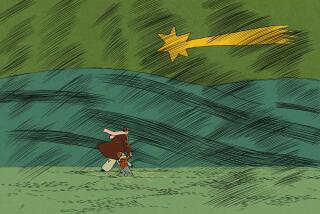Book Ascribed to Jesus’ Half Brother Tells a Different Christmas Story
- Share via
It’s the Christmas story you probably haven’t heard before.
The characters are much the same: There’s Joseph, Mary, the Magi, and, of course, the newborn Jesus. There’s also a donkey, a trip to Bethlehem and a star in the east.
But that’s about where the similarities end between the familiar accounts of Jesus’ birth and the one told in the Infancy Gospel of James, a noncanonical book about Mary and the birth of Jesus purportedly written by Jesus’ half brother.
The ancient Infancy Gospel includes these details:
* Two of Joseph’s sons accompanied their father and Mary as they traveled from Nazareth to Bethlehem for the Roman census.
* Halfway through the trip--before reaching Bethlehem--Mary delivered Jesus in a cave by the roadside.
* While Mary was in labor, Joseph ran off to find a midwife.
* As Mary gave birth, Joseph experienced a sort of time warp in which all activity around him appeared momentarily suspended.
* Eventually, two midwives arrived at the cave. The second midwife, named Salome, performed a physical examination of Mary to assuage her doubts that a virgin had given birth.
Although some material does overlap the accounts of Jesus’ birth as told in Matthew and Luke, the Infancy Gospel “tells a very different and much more detailed story,” writes USC religion professor Ronald F. Hock in the newly published “The Life of Mary and the Birth of Jesus” (Ulysses Press).
The Infancy Gospel of James is a protevangelium, or pre-Gospel text, because it begins well before the life of Jesus; it is among the early Christian writings that were not included in the New Testament. The uncomplicated story, which focuses on the life of Mary and stresses her piety and purity, ends with the birth of Jesus. It does not include any of Jesus’ teachings, nor does it recount the major events of his life or death.
“It’s kind of fluff,” Hock said.
“It’s a simple story and more sentimental than profound. It doesn’t meet the requirements of what theologians would like in a document,” he surmised when asked why the Infancy Gospel is not part of the Bible.
“But,” he added, “there’s nothing heretical about it.”
The Infancy Gospel also offers details such as:
* Mary’s parents, Joachim and Anne, were only able to conceive after being visited by a heavenly messenger.
* Joseph, described as an old carpenter with grown sons, was chosen to take care of Mary after a dove flew from his staff and perched on his head.
* When Mary’s pregnancy was discovered, Joseph was accused by the Temple priests of sexually violating the virgin left in his care.
But above all else, the slim Gospel painstakingly stresses that Mary was a virgin even after Jesus’ birth.
“The Infancy Gospel was written to praise Mary and explain why she was chosen to be the mother of God,” Hock said.
Yet to many scholars, the author remains a mystery.
Hock believes the text was written during the 2nd century--well after the death in AD 62 of James, Jesus’ half brother--because of the author’s use of a specific literary style, called an encomium, which follows strict rules of composition and was used during that era to praise subjects. Because of the author’s “confusion about the geographic relation of Bethlehem to Jerusalem and Judea,” Hock also writes that the author was “a stranger” to the Holy Land.
More to Read
Sign up for Essential California
The most important California stories and recommendations in your inbox every morning.
You may occasionally receive promotional content from the Los Angeles Times.













